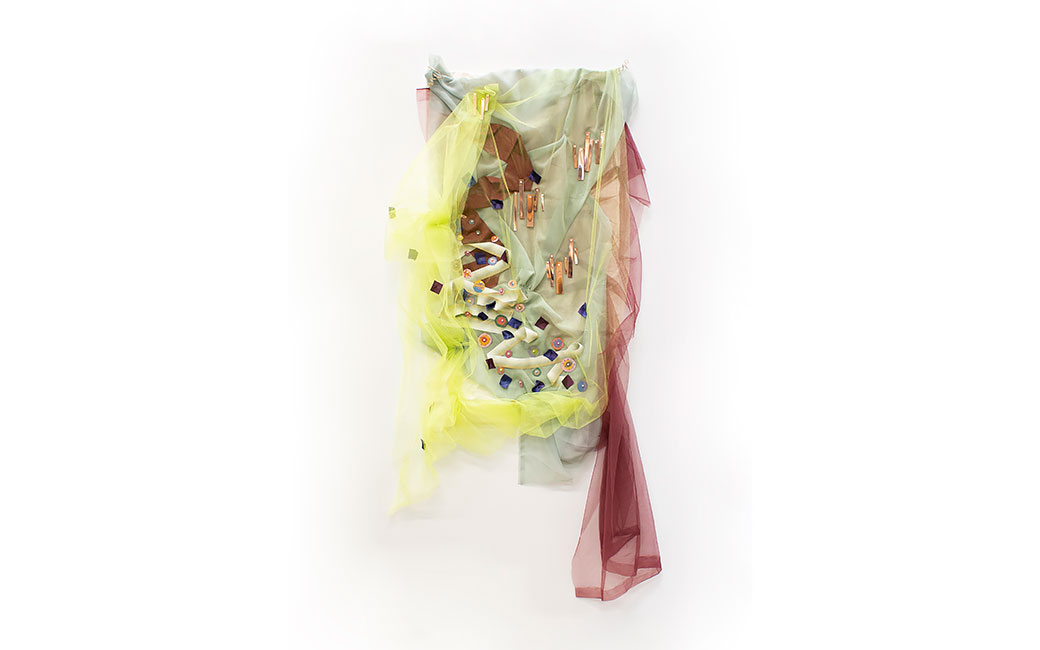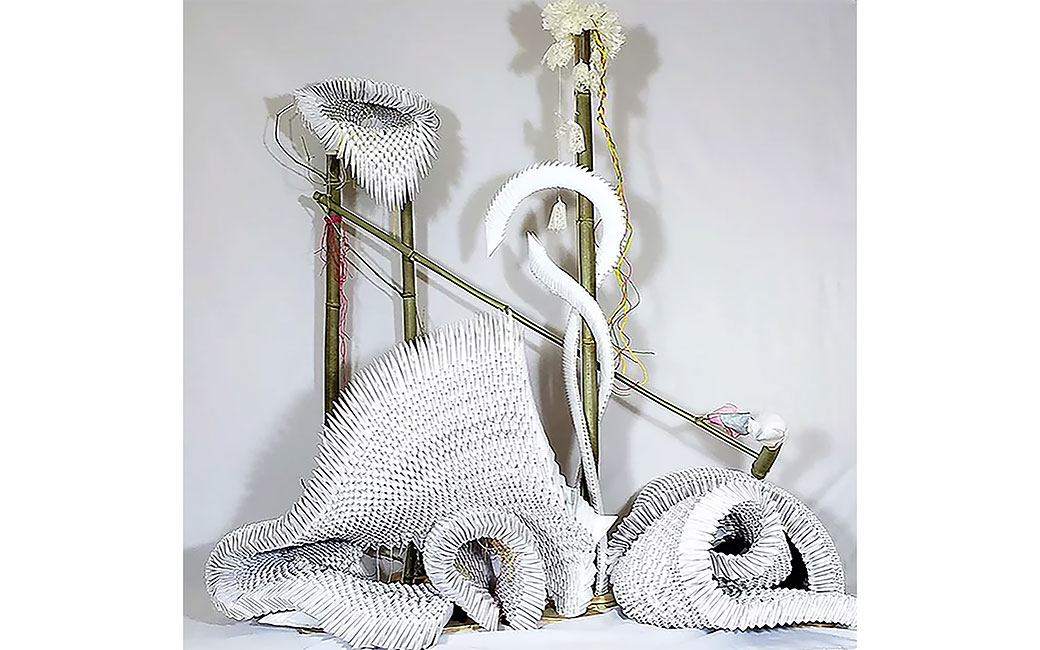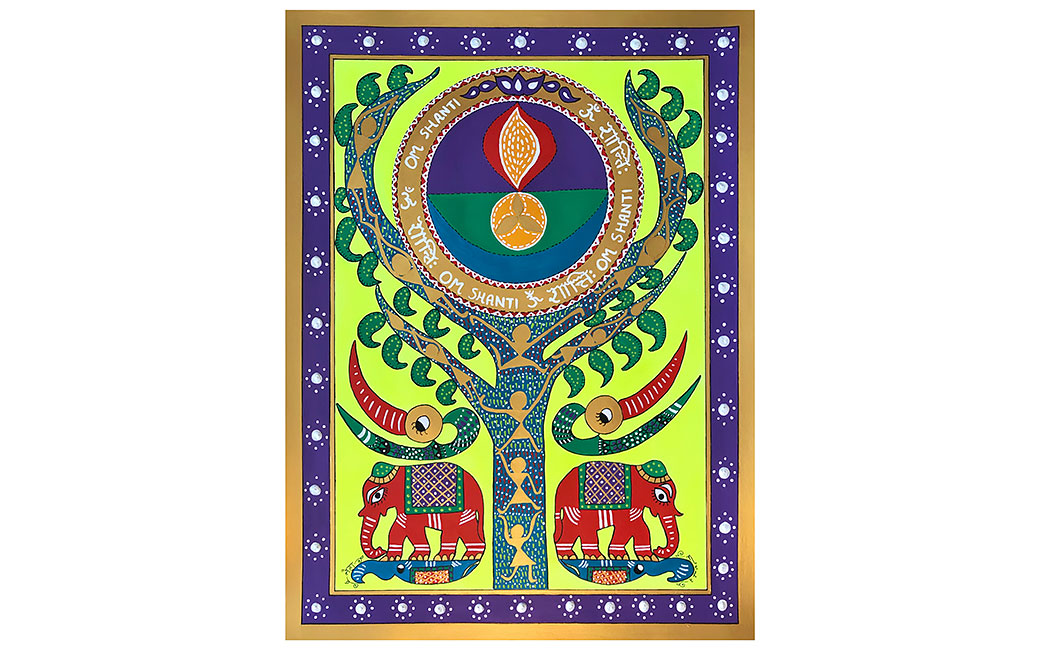
Responses to the COVID-19 Pandemic
The artists in this section use their art as a form of expression and resistance in the times of the COVID-19 pandemic. Using art to express not only their own experiences with a global pandemic, but also the ignorant rhetoric and surge of Asian hate and violence towards the AAPI community.
Karen Li
A vision of the River Styx with the ferryman’s payment awash among the current and a glint of light on the waves. Playful color and dynamic texture shift the somber connotations of the river of death to a more optimistic perspective. The metal elements recall rituals of death that pertain to the living. Painted coins depict obols placed on the eyes of the deceased to ensure safe passage to the underworld for a loved one. Polished copper suggests the reflection of the Mirror of Retribution in the Chinese underworld, where souls review the deeds and misdeeds of their previous existence. When your turn comes to look into the mirror, will you like what you see?
I am a theater and dance artist who left New York during COVID and settled in Baltimore. Though I do not set out to make work about the pandemic, it is nearly impossible to step away from themes of isolation and mortality when they hang so stubbornly over every element of our new lives. Our collective isolation during the past year echoes the loneliness of the immigrant experience. This piece speaks to the insecurities that bring and attempt to release some weighty attachments as we all prepare for the future.
Sookkyung Park
During the pandemic period, I folded nearly 10,000 printing papers. At first, I didn’t have any special plans for what to make. But as time passed, I came to think about what my own identity and my cultural background is. To express it, I created this work by mixing traditional colors, traditional paper, and thousands of folded papers interlocking together. Bamboo represents the symbol of longevity. The traditional paper was used to form a lantern and some flowers, and the traditional paper strings were used to express the storyline in the colors that appear in traditional Korean women’s clothing. In addition, in order to accentuate the characteristics of the paper, the soft curves of the work were emphasized by woven bamboo and hemp cord without using glue. This work is intended to express my identity and harmony with the new culture by mixing traditional and mechanical paper.
Sookkyung Park established an arts and crafts studio in 1982 and maintained the studio for 25 years in South Korea. In 2011, she emigrated in her 50's and received a B.A. in Studio Arts from University of Maryland, College Park in 2016. After graduating, she joined the HMAA GW (Han-Mee Artists Association of the Great Washington, DC). She participated in several regional and international juried exhibitions and solo exhibition at Consulate General of the Republic of Korea. As a Towson University MFA candidate, Sookkyung is exploring the harmony between origami, bamboo and traditional paper. Sookkyung is also a member of the Washington Sculptors Group, and Vice President of the HMAA GW.
Learn More about Sookkyung Park
Momma Rain
Inspired by the former president’s usage of racism during a pandemic.
Momma Rain has been creating art since forever, reflecting the way she sees and experiences the world in her own unique way. A first generation Filipino-American, who grew up in Maryland around the suburbs of DC, spent time in Baltimore and now resides between Baltimore and Annapolis. Her art reflects who she is and her experiences being a minority in Maryland. She primarily works in acrylics painting portraitures of faces and people around her who, like who, reflect the many faces of America.
Learn More about Momma Rain
Neha Misra
I made this painting in the early days of the lockdown as I meditated on the meaning and rhythms of the Shanti Mantras — the Peace Prayers found in the Upanishads. I listened to Ravi Shankar’s “Shanti Mantra” (from the album, Bridges) during much of the making of this painting. I often start my days with this chant meant to calm the mind of the reciter and the environment around them/her/him. The recitation of peace prayers is rooted in the desire to calm the mind and remove obstacles in three realms: The first, is the physical or Adhi-Bhautika realm that represents the external world. The second, is the Divine or Adhi-Daivika realm that represents the extra-sensory world. Lastly, the third which is the internal or Adhyaatmika realm that represents one’s inner body and mind. To me, peace and justice are deeply intertwined, for there can be no lasting peace without a just society. In his letter from the Birmingham jail, Martin Luther King, Jr. writes of a negative peace which is the absence of tension vs a positive peace which is the presence of justice. The Peace Tree painting is a deep wish for realization of positive peace for people and beings everywhere. The journey is long, and we sure need strength in body, mind and spirit as the peace prayers remind us.
Neha Misra is a contemporary visual folk artist, poet, and an award-winning global climate justice advocate. Neha’s Earth stewardship centered creative studio fosters planetary healing through the cathartic power of multi-disciplinary art forms. Neha’s paintings draw inspiration from diverse Indian folk-art traditions and sacred geometry knowledge systems of her heritage, her foundational education in Physics, and a deep reverence for Mother Earth embodied in her lifelong environmental work.


